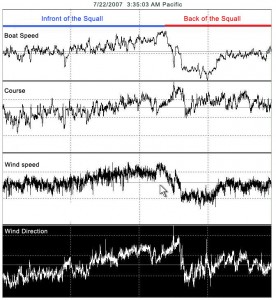July 22 09:45 utc – lat 25 17 N, lon 141 33 W
Squally night. They come from right to left. So far we’ve been really lucky. The wind lifted a lot. If it persists, we will jibe in the morning at daybreak. There are flying fish everywhere. As I was steering down a wave, I got hit in the arm by a big one. One does get startled, especially in the dark. I bet that we’ll find it in the cockpit in the morning. Flying fish live in schools and probably see the Pegasus as a giant predator. Their natural instinct is to fly away. That’s why they developed wings.
In the morning we’ll decide whether to jibe or not. Time to get a couple of hours of sleep now that Richard relieved me. All things are good.
Using our sensors on the Pegasus, we analyzed the effect of a North East Pacific rain squall. Note that bursty squalls like these tend to behave differently on diverse oceans. The following analysis from our sensor network shows that in the front of the Squall, the wind increases significantly, goes right and so does the boat speed and the heading. As soon as the squall passes overhead, the wind drops dramatically. That is typical. The graphic speaks for itself:
